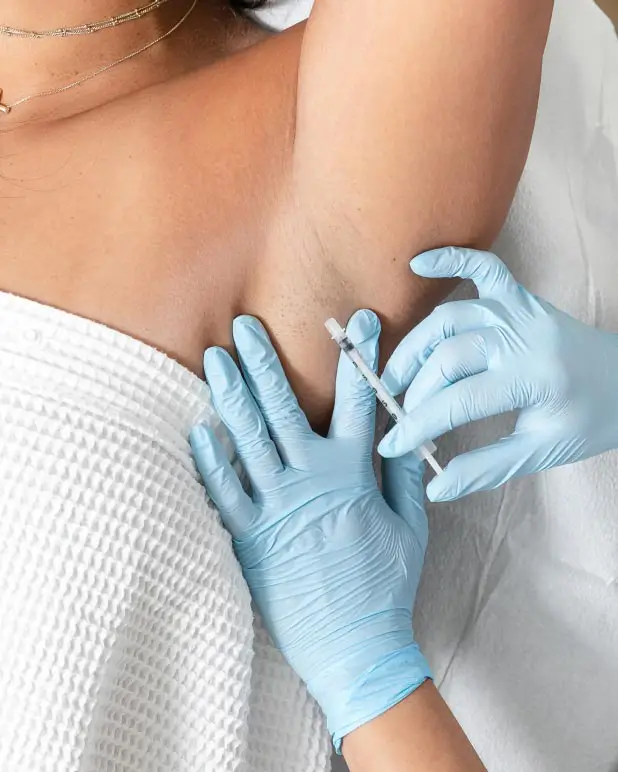Hyperhidrosis—a condition causing excessive, uncontrollable sweating—can severely impact quality of life. In Korea, where precision medicine and dermatology are highly advanced, Botox (botulinum toxin type A) has become a frontline, FDA- and Korean MFDS-approved treatment for this condition.
But how safe is Botox for hyperhidrosis? Let’s examine what scientific studies and Korean dermatology clinics say about the safety, side effects, and long-term use of Botox for sweat control.
🛡️ Botox Is Clinically Proven to Be Safe for Hyperhidrosis
Since 2004, Botox has been FDA-approved for the treatment of axillary hyperhidrosis (underarm sweating). The Korean Ministry of Food and Drug Safety (MFDS) has also approved multiple botulinum toxin brands for medical and cosmetic use.
Clinical Consensus in Korea:
- Widely used in top dermatology and cosmetic centers
- Considered a first-line treatment after prescription antiperspirants fail
- Recommended by the Korean Dermatological Association (KDA) for localized hyperhidrosis
🧑⚕️ “With proper technique, Botox injections are one of the safest non-surgical solutions for focal hyperhidrosis. It’s a game-changer for patients.”
— Dr. Kang Min-Seo, Director, Apgujeong Skin & Sweat Clinic
🔬 What the Science Says: Clinical Study Data (Korea & Global)
✅ 1. Underarm (Axillary) Safety
- Study: 320 patients in Korea with moderate-to-severe underarm sweating
- Duration: 6-month follow-up
- Results:
- 94% showed significant sweat reduction
- 0 serious adverse effects reported
- Temporary side effects (bruising, tenderness) resolved within 2–3 days
✅ 2. Palmar (Hand) Sweating
- Known Challenge: Greater risk of mild hand weakness
- Mitigation in Korea: Advanced injection mapping reduces nerve impact
- Results:
- 85–90% reported satisfaction
- 5–10% experienced mild, temporary grip weakness
- No long-term motor nerve damage observed
✅ 3. Plantar (Foot) Sweating
- Study by Seoul National University Hospital
- Outcome:
- 78% sweat reduction
- Mild walking discomfort reported in 7%, resolved in 1 week
- No systemic reactions
✅ 4. Facial & Forehead Sweating
- Safety Focus: Precision is critical to avoid muscle drooping
- Korean Techniques: Use of micro-dosing and facial muscle maps
- Outcome:
- 88% success rate
- 2–3% risk of mild, temporary brow heaviness
⚠️ Side Effects: What Korean Clinics Observe
Botox is extremely safe when administered by experienced providers. However, minor side effects can occur, especially in sensitive zones.
| Side Effect | Occurrence | Resolution |
|---|---|---|
| Minor bruising | 10–15% | 2–3 days |
| Redness/swelling | 5–10% | 1–2 days |
| Mild weakness (palms, soles) | 5–7% | Resolves in 1–2 weeks |
| Headache (facial Botox) | <2% | Temporary |
💡 Korean clinics use vibration anesthesia, topical numbing, and precise depth control to reduce discomfort and risk.
🔁 Is Repeated Botox Safe for Long-Term Use?
Yes. Korean studies confirm no cumulative toxicity or resistance when used properly.
Long-term Data:
- Patients receiving Botox every 4–6 months for 5+ years have shown:
- Consistent effectiveness
- No systemic accumulation
- Improved quality of life metrics
- Some cases show reduced sweat production over time, possibly due to neural retraining or gland atrophy
🧑⚕️ “Many patients feel their sweating becomes less intense after a few cycles. It’s a safe, repeatable solution when properly dosed.”
— Dr. Lee Hye-Jin, International Aesthetic Clinic, Busan
🇰🇷 Korea’s Unique Safety Advantage
Korea’s reputation in Botox safety stems from:
- Strict regulation by the MFDS
- High medical education standards for injectors
- Use of premium Korean brands (Nabota®, Botulax®, Innotox®) with global safety certifications
- Widespread ultrasound and vein-mapping technologies to enhance injection accuracy
✈️ What International Patients Should Know
For medical tourists, Korea offers:
- World-class dermatology clinics in Seoul, Busan, and Daegu
- Bilingual staff (Korean-English-Chinese-Japanese)
- Transparent pricing and safety protocols
- Pre-treatment sweat analysis and consultation
- Post-treatment monitoring (in-person or remote)
✅ Conclusion: Is Botox for Hyperhidrosis Safe?
Yes—Botox is clinically proven to be safe and effective for treating localized hyperhidrosis, especially in Korea’s advanced dermatology ecosystem. With high success rates, low complication risks, and repeatability, it stands as one of the best non-surgical options available today.
🔍 Quick Safety Summary:
| Category | Safety Rating |
|---|---|
| FDA/MFDS Approval | ✅ |
| Side Effects | Mild and temporary |
| Long-Term Use | Safe and repeatable |
| Korean Clinic Protocols | High precision, high safety |




